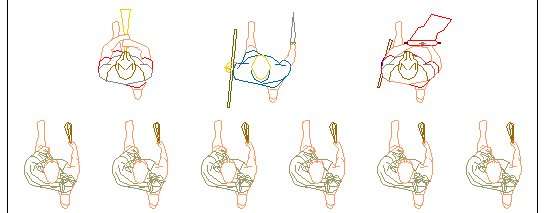March: the legion components
The next several sections describe the men, animals and equipment that were associated with the legion; that is, the numbers of these units were more or less related to the number of legions in an army. Units more directly associated with the army as a whole (headquarters staff and auxiliary cavalry, for example) are described under the section titled The Army.
The contubernium
 Throughout the centuries it seems that the basic unit of the Roman army was the contubernium, the tentmates (see also Duncan Campbell's article in issue XII.2). There is ambiguity and disagreement among the sources about the number of men that made up a contubernium. Some consider the contubernium to have consisted of 8 soldiers, others 10, with 2 on watch.
Throughout the centuries it seems that the basic unit of the Roman army was the contubernium, the tentmates (see also Duncan Campbell's article in issue XII.2). There is ambiguity and disagreement among the sources about the number of men that made up a contubernium. Some consider the contubernium to have consisted of 8 soldiers, others 10, with 2 on watch.
What does seem clear is that only 8 men could sleep in the standard 10' by 10' tent. The discrepancies are in whether the tent-unit included 10 men with two always on watch or was just 8 men.
There are difficulties with either solution. As noted in the description of the Roman camp, if one tent, mule and servant were allocated to each 8 soldiers then the camps are not large enough. More tents would be required than the camp diagrams show. If one tent is allowed for each 10 soldiers then there is a problem with the other two, where were they positioned while on watch?
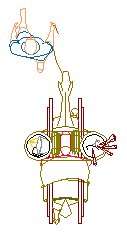 I am not attempting to completely resolve the question here, but some assumptions have to be made to create a model. For my purposes I have considered the contubernium to have been 10 soldiers. The elements of the contubernium are: 10 soldiers, 1 10' by 10' tent, 1 mule and 1 servant. The mule is cared for and led by the servant (calo). The tents poles and stakes are estimated to weigh 40 pounds. The maximum load for a pack animal was estimated at 200 pounds but one was assigned to each tent to carry the extra food, baskets for excavating trenches, a handmill to grind grain, and a variety of other tools and equipment.
I am not attempting to completely resolve the question here, but some assumptions have to be made to create a model. For my purposes I have considered the contubernium to have been 10 soldiers. The elements of the contubernium are: 10 soldiers, 1 10' by 10' tent, 1 mule and 1 servant. The mule is cared for and led by the servant (calo). The tents poles and stakes are estimated to weigh 40 pounds. The maximum load for a pack animal was estimated at 200 pounds but one was assigned to each tent to carry the extra food, baskets for excavating trenches, a handmill to grind grain, and a variety of other tools and equipment.
The pack mule for the contubernium is shown in the detail to the left. The pack includes a folded tent, the tent poles, two large baskets on either side filled with tools and cooking utinsels, and a sack of grain.
The centurion
Each centurion is assigned his own tent, a mule and a servant. Peddie says the centurion's tent was 10' by 20', but most others describe it as 10' by 10'.
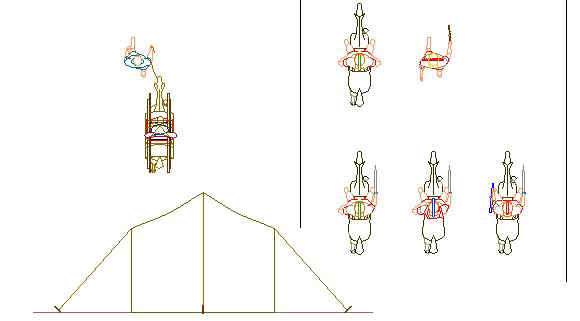 The illustration shows the 10' by 10' high walled tent assigned to officers. The officers assigned this style of tent are shown on the right; they are are, top left to bottom right: a faber (an non-combatant engineer, hence no weapon), the centurion, a noble youth, an officer (unspecified) and a tribune. Each of these officers is assigned one mule to carry the tent and their personal gear. The mules packs are different from that of the contubernium since there are no entrenching tools used.
The illustration shows the 10' by 10' high walled tent assigned to officers. The officers assigned this style of tent are shown on the right; they are are, top left to bottom right: a faber (an non-combatant engineer, hence no weapon), the centurion, a noble youth, an officer (unspecified) and a tribune. Each of these officers is assigned one mule to carry the tent and their personal gear. The mules packs are different from that of the contubernium since there are no entrenching tools used.
Optio: The optio may or may not have had a tent. Judson speculates that two may have shared a tent. The camp layouts do not include any space for the optiones so no special pack animals for them are included in the march model. (See note below under aeneatores for a more thorough discussion of the optio.
Servants
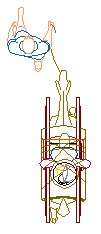 All authors agree that 8 men could sleep in the contubernium tent and modern reenactors confirm this. On this basis, 1 tent is assigned to each 8 servants since none of them would have been on watch. In most cases I allotted 1 tent to each 8 servants, but where there were 9 or 10 in a unit, rather than add a tent for one or two people, I crowded the extra servants into the one tent. Some servants could have shared tent space with their masters; so, although I have no authority for this, it is noted as a possible option in various places.
All authors agree that 8 men could sleep in the contubernium tent and modern reenactors confirm this. On this basis, 1 tent is assigned to each 8 servants since none of them would have been on watch. In most cases I allotted 1 tent to each 8 servants, but where there were 9 or 10 in a unit, rather than add a tent for one or two people, I crowded the extra servants into the one tent. Some servants could have shared tent space with their masters; so, although I have no authority for this, it is noted as a possible option in various places.
The pack mule for the servants is again slightly different from that for the contubernium. It lacks the baskets and entrenching tools but has some additional cooking utensils. The tent represented is the same size as that for the contubernium.
The century
 The size of the century varied from time to time in the history of the legion. There were noticeable differences between actual and theoretical legion strength as well. For the purpose of the models I have considered the century to be 80 men: 8 contubernia, 1 centurion, a signifer and an aeneator (either a cornicen or a tubicen). The camp models do not allow room for the aeneatores or signiferi to tent with the centuries, they may have been camped together at the center. Wherever they were camped, they would require one tent for each 8 or 10 soldiers. The number of tents for these units is considered later.
The size of the century varied from time to time in the history of the legion. There were noticeable differences between actual and theoretical legion strength as well. For the purpose of the models I have considered the century to be 80 men: 8 contubernia, 1 centurion, a signifer and an aeneator (either a cornicen or a tubicen). The camp models do not allow room for the aeneatores or signiferi to tent with the centuries, they may have been camped together at the center. Wherever they were camped, they would require one tent for each 8 or 10 soldiers. The number of tents for these units is considered later.
The drawing at the left shows the first century of the first cohort in a marching formation. Leading the century are the standards of the legion itself ( the first rank), then a contingent of aeneatores (second rank), then a cornicen, the primus pilus (the centurion of the first century) and the signifer of the first century. Following them are 12 ranks of legionaries in 6 files, 72 men. The remaining 8 men are shown at the bottom of the formation. According to Connolly and Peddie, one man from each contubernium were detailed to the survey unit to mark out the new camp. Since these 8 men would not have marched with the rest of the century they are shown separated.
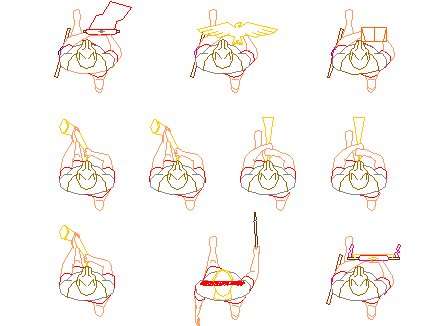 The enlargement at the right shows the legion standard bearers: (left to right) a vexillarius with the name of the legion on a banner, the aquilifer and an imaginifer (image of the emperor in later legions). The second row shows two cornices and two tubicines drawn from the legion aeneatores to escort the standards. The third row shows the cornicen assigned to the first century (the second century would have had a tubicen assigned to it), the centurion marching with his vine rod, and the standard bearer of the century.
The enlargement at the right shows the legion standard bearers: (left to right) a vexillarius with the name of the legion on a banner, the aquilifer and an imaginifer (image of the emperor in later legions). The second row shows two cornices and two tubicines drawn from the legion aeneatores to escort the standards. The third row shows the cornicen assigned to the first century (the second century would have had a tubicen assigned to it), the centurion marching with his vine rod, and the standard bearer of the century.
The drawing to the left shows the baggage associated with the century. There is one mule (top right) for the centurion's tent and personal gear, 8 mules for the 8 contubernia and one mule (bottom) for the servants' tent.
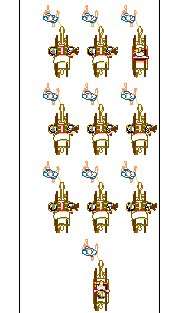 Peddie's description provides a small cart to hold the centurion's tent and personal gear. He notes that when the army was called to march in battle-ready order that the personal gear of the rest of the century could be loaded onto the cart as well.
Peddie's description provides a small cart to hold the centurion's tent and personal gear. He notes that when the army was called to march in battle-ready order that the personal gear of the rest of the century could be loaded onto the cart as well.
Trajan's column seems to support the presence of carts for hauling tents and legionary gear but certainly one cart could not carry the 40 pounds of personal gear for each of the 80 members of the century. Trajan's column also shows the soldiers carrying their own gear, and it seems certain that at least some armies did not provide carts for gear. I have not included carts for either the centurion's tent and gear or for the legionaries.
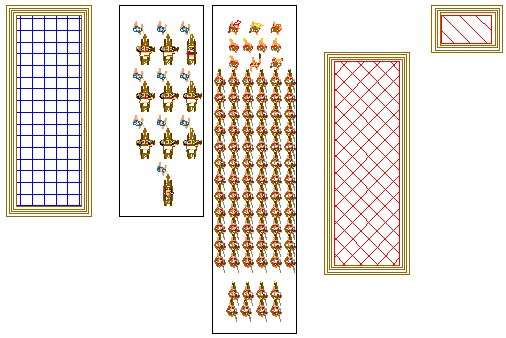 This drawing shows the soldiers (right column) and baggage train (left column) for the first century. On either side are boxes which are used in later drawing to represent these units. The small red box to the upper right represents the legion standards, the larger red hatched box on the right represents the size of the century formation itself. Note that the 8 men detailed to the survey unit are not included in the hatched box size. The blue hatched box on the left represents the size of the baggage train for a century. These boxes are used in place of individual figures when the larger models of the army on the march are developed.
This drawing shows the soldiers (right column) and baggage train (left column) for the first century. On either side are boxes which are used in later drawing to represent these units. The small red box to the upper right represents the legion standards, the larger red hatched box on the right represents the size of the century formation itself. Note that the 8 men detailed to the survey unit are not included in the hatched box size. The blue hatched box on the left represents the size of the baggage train for a century. These boxes are used in place of individual figures when the larger models of the army on the march are developed.
The maniple and cohort
![]() Two centuries made one maniple and three maniples made up one cohort. The illustration at the right shows the 6 centuries of the cohort on the right and the associated baggage train on the left. The two centuries of the maniple have 10' between them, as do their respective baggage trains. There is 20' between each maniple. The borders of the three maniples are colored, top to bottom, blue, red and green to help distinguish them.
Two centuries made one maniple and three maniples made up one cohort. The illustration at the right shows the 6 centuries of the cohort on the right and the associated baggage train on the left. The two centuries of the maniple have 10' between them, as do their respective baggage trains. There is 20' between each maniple. The borders of the three maniples are colored, top to bottom, blue, red and green to help distinguish them.
The legion
Ten cohorts make up one legion. In the illustration below the odd numbered cohorts are colored red, the even numbered, blue. The ten cohorts take 3,726 feet in the column of march, the baggage train for the legion is nearly as long, 3,580 feet.
The decuria, turma, and ala
 This illustration is a detail showing, left to right, a cavalryman walking, leading his horse, a cavalryman mounted and the decurio. The walking figure is is taken from photographs of reenactors and the way they carry their gear.Various items of his personal gear, including his helmet, can be seen hanging from the saddle horns. The cavalrymen in the illustration of the turma, above, are shown walking their horses. In fact, the mounted units, especially the cavalry, but also the evocati and bodyguards, were used as scouts and guards during the march. At least some of the units (the advance scouts, flankers, rear guards, for example) would have marched in a battle-ready condition, more like the center figure. The decurio is shown mounted and armed with a sword to distinguish him from the ordinary cavalryman. The sword is simply a convention I have elected to use to distinguish officers, it is not meant to imply that the decurio did not carry a spear.
This illustration is a detail showing, left to right, a cavalryman walking, leading his horse, a cavalryman mounted and the decurio. The walking figure is is taken from photographs of reenactors and the way they carry their gear.Various items of his personal gear, including his helmet, can be seen hanging from the saddle horns. The cavalrymen in the illustration of the turma, above, are shown walking their horses. In fact, the mounted units, especially the cavalry, but also the evocati and bodyguards, were used as scouts and guards during the march. At least some of the units (the advance scouts, flankers, rear guards, for example) would have marched in a battle-ready condition, more like the center figure. The decurio is shown mounted and armed with a sword to distinguish him from the ordinary cavalryman. The sword is simply a convention I have elected to use to distinguish officers, it is not meant to imply that the decurio did not carry a spear.
The turma formation is shown below.
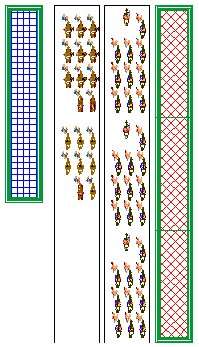 The number of Roman cavalry assigned to the legions varied over time but an early standard seems to have been 330 to the legion organized into a unit called the ala (wing). It was comprised of ten turmae. Each turmaconsisted of three decuriae of 10 soldiers and an officer called a decurio. The three decuriae of a turma are illustrated on the right.
The number of Roman cavalry assigned to the legions varied over time but an early standard seems to have been 330 to the legion organized into a unit called the ala (wing). It was comprised of ten turmae. Each turmaconsisted of three decuriae of 10 soldiers and an officer called a decurio. The three decuriae of a turma are illustrated on the right.
Pack train: Each decuria has one tent for its ten soldiers and one for its officer. One additional tent is added for the servants, making a pack train of 7 animals for each turma. The top part of the baggage train shows these mules.
The turmae which did march in a battle-ready condition would need pack mules for their personal gear. The additional pack train for the turma is illustrated in the bottom part of the baggage train: 7 mules for the 33 men of the turma plus one mule for the tents for these servants.
The illustration below shows the 10 turmae of the Roman ala with its associated baggage train.
The ten turmae would not have marched in this formation since they used to scout in advance, guard the flanks and read and guard officers and important baggage. I show the distribution of the Roman cavalry forces later in conjunction with the auxiliary cavalry.
Tribunes
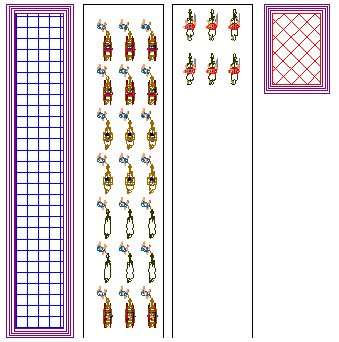 Each legion had 6 tribunes who served as officers to the legate. They are shown in the illustration on the left with their baggage train. The tribunes are shown as mounted officers.Each tribune has a tent, a personal pack mule and one extra horse that is led by a servant. Three tents are required for their servants.
Each legion had 6 tribunes who served as officers to the legate. They are shown in the illustration on the left with their baggage train. The tribunes are shown as mounted officers.Each tribune has a tent, a personal pack mule and one extra horse that is led by a servant. Three tents are required for their servants.
Legate
Each legion was under the command of a legatus. The legate is assigned a large tent that requires two mules to carry, 4 personal pack mules, and and extra horse. There is one tent for the servants.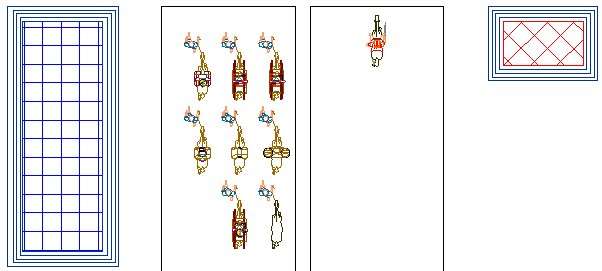
Signiferi
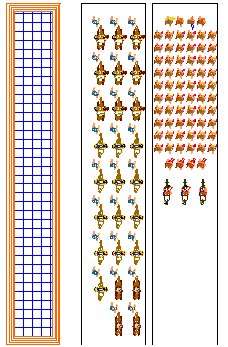 The signiferi are always mentioned but there is seldom a specific allowance made for them when the army is described. For example, the usual descriptions do not mention tent locations in the camp or baggage requirements.
The signiferi are always mentioned but there is seldom a specific allowance made for them when the army is described. For example, the usual descriptions do not mention tent locations in the camp or baggage requirements.
A "typical" number of signiferi for a legion is illustrated at the left. The illustration itself may be misleading in that the signiferi never marched together as a unit but were disbursed throughout the other formations. However, to ensure that they are properly accounted for, I have assembled them all together here.
The first rank has four signiferi in it. They represent the signiferi of the legion proper are are, left to right, an aquilifer, imaginifer, draconarius and an old style signifer carrying a taurus, bull, standard. Following them are the 60 signiferi for the centuries. Then come four vexillarii for the four centuries of antisignani and finally three mounted signiferi: a vexillarius for the legion itself (shown mounted because he accompanies the legate), a vexillarius for the Roman ala, and a draconarius for the ala.
For more information about the variety of standards used by the army please see the page Equipment.
Not all of these signiferi would have been present in every legion, or in any actual historical legion for that matter. I have shown them here to indicate the range of standards associated with a legion.
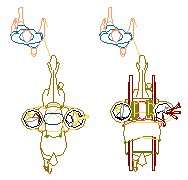 There are a total of 71 signiferi illustrated above. I assigned one tent to each 8 signiferi since they would probably not be on watch duty. In most illustration of the march the signiferi are shown carrying their standards. This would seem to preclude them from also carrying their gear, as the normal legionary does. Therefore an additional 13 mules have been added to carry their personal gear. And finally, the pack train shows the 4 tents that would be needed by the servants.
There are a total of 71 signiferi illustrated above. I assigned one tent to each 8 signiferi since they would probably not be on watch duty. In most illustration of the march the signiferi are shown carrying their standards. This would seem to preclude them from also carrying their gear, as the normal legionary does. Therefore an additional 13 mules have been added to carry their personal gear. And finally, the pack train shows the 4 tents that would be needed by the servants.
The illustration at the right shows the mule pack on the left for the signiferi and aeneatores personal gear and on the right, the pack for the tent and the contuberniumequipment.
Aeneatores
 Aeneator is the generic name for the soldiers who carried the signaling horns. Just like the signiferi, the aeneatores did not march together but were disbursed throughout the legion. They are shown here gathered together. The usual numbers for a legion, following Connolly, are: one cornicen is assigned to the first century and one tubicen to the second; 30 each per legion plus 3 of each to the cavalry units, 1 tubicen to the legate in command of the legion and 1 tubicen to the first tribune. In imperial armies he further assigns 5 each to the first cohort, but these 5 are not included in this model. He assignes one bucinator to each cohort, 1 to the cavalry and 1 to the legate in command.
Aeneator is the generic name for the soldiers who carried the signaling horns. Just like the signiferi, the aeneatores did not march together but were disbursed throughout the legion. They are shown here gathered together. The usual numbers for a legion, following Connolly, are: one cornicen is assigned to the first century and one tubicen to the second; 30 each per legion plus 3 of each to the cavalry units, 1 tubicen to the legate in command of the legion and 1 tubicen to the first tribune. In imperial armies he further assigns 5 each to the first cohort, but these 5 are not included in this model. He assignes one bucinator to each cohort, 1 to the cavalry and 1 to the legate in command.
To this number I have added two cornicines and two tubicines for the centuries of archers and slingers, these are shown walking beside the mounted aeneatores. I have shown the aeneatores assigned to the ala and to the legate as mounted.
The illustration on the left shows the aeneatores divided into three groups. First are the 36 cornicines, next are the 37 tubicines and last are the 12 bucinatores.
The mule train is led by 11 mules carrying the tents, followed by 16 with personal gear and then the four for the servants' tents.
A note about the optiones, signiferi and aeneatores: It is unclear to me whether or not these soldiers were drawn from the ranks of the centuries or were additional soldiers. In favor of the first view are two points. (1) Some sources say that the best and bravest soldiers in the century were given the honor of carrying the standards. (2) The camp layout diagrams I have seen do not provide any separate tents for the optiones. These factors would seem to indicate that a century of, say, 80 would include the optio, signifer and cornicen and that only the centurion would be an additional soldier. Some illustrations of the formation of the century show the optio as a member of the last rank of the century formation, others show the optio standing apart from a complete century formation. In favor of the second view are the illustrations and diagrams used by the various authorities. Every illustration of the century that I have seen shows the signifer and the aeneator as additional soldiers. Conclusion: I have not shown the optio as a separate position in any illustrations, nor have I made a special allowance for him in the arrangement of tents in the camp or in the baggage train. I have shown the signiferi and aeneatores as separate units; that is, as soldiers in addition to the centuries. As such, they require the tents and baggage trains I have shown above.
Antesignani
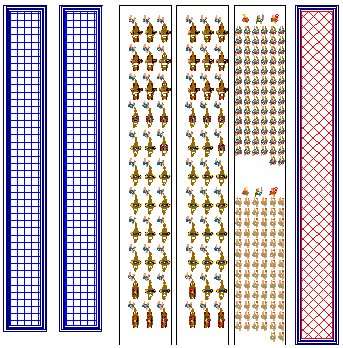 In the earliest legions the skirmishers were the velites attached to the third line. In later legions they consisted of auxiliary units of specialists, mostly slingers and archers. For the model of the march I have assigned 2 centuries of archers and 2 centuries of slingers to each legion.
In the earliest legions the skirmishers were the velites attached to the third line. In later legions they consisted of auxiliary units of specialists, mostly slingers and archers. For the model of the march I have assigned 2 centuries of archers and 2 centuries of slingers to each legion.
The illustration at the right shows a century of archers followed by a century of slingers. Each century is led by an officer, either a cornicenor a tubicen and a vexillarius.
The pack trains for each of the centuries is shown on the left. The trains are long for several reasons. The skirmishers were used as advance scouts during the march. Because of the nature of their weapons (lead shot or stones, bows and arrows ) they would require some additional supply. Four mules, one for each 20 skirmishers, have been assigned for this purpose. If these soldiers were on active duty as light fast infantry they would not have carried their own gear, as did the legionaries. Since the load for one man is usually set at 40 pounds, one mule for each 5 men has been assigned for personal gear. this makes for a considerable pack train, a total of 33 mules per century to carry the tents, gear and servants tents.
The illustration below shows a close-up of the officer, cornicen and vexillarius leading the archers.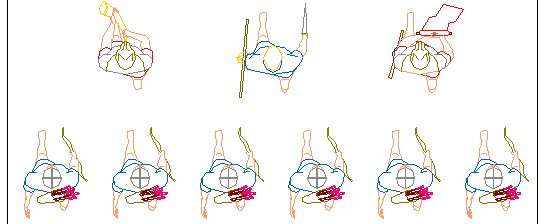
The illustration below shows the first rank of the slingers, led by a tubicen, an officer and a vexillarius.
I have no authority for the presence of an officer, signifer or aeneator with these units; but, given the way the rest of the legion is organized it seemed more reasonable to provide for these men than to ignore their possible presence.


